The last post highlighted a few shade planters, and I hope this one will give you ideas for your hot, sunny spots. Even with large planters maintaining a set watering schedule is important when plantings are sited in full sun. If your plantings wilt as a result of being too dry between watering over and over, eventually they’ll become so stressed they won’t recover. So, if you’ll be leaving for any extended period, ask a neighbor or friend to check your plantings and water regularly.
The first planting is a classic “Thriller, Filler, Spiller” combination, designed for a tall urn, using a silver foliage plant called cardoon. It will get very large, creating a dramatic centerpiece while the mounding, succulent echevarias fill the middle with their pinky gray rosettes. The beautiful heat tolerant trailing dichondra creates a waterfall of shimmery silver over the edge. This is the most drought tolerant of the plantings shown here but still needs attention – even succulents need water!
 The next uses a red fountain grass for height in a tall planter with the addition of white Profusion zinnias and white euphorbia as fillers. Spilling out are blue daze and potato vine. This planting will bloom continuously with regular water and periodic deadheading or clipping back of the zinnias. Late in the summer the grass will begin to bloom for an end of the season finale.
The next uses a red fountain grass for height in a tall planter with the addition of white Profusion zinnias and white euphorbia as fillers. Spilling out are blue daze and potato vine. This planting will bloom continuously with regular water and periodic deadheading or clipping back of the zinnias. Late in the summer the grass will begin to bloom for an end of the season finale.

This wheelbarrow is a fun and bright mix of flowers and herbs and will provide a riot of color through the hottest months. This type of whimsical container calls for a jumble of color, and here it’s provided by zinnias, vinca, fanflower, rudbeckia, ornamental oregano, purple basil, and thyme. It would be perfect in the middle of a cottage kitchen garden! It will be necessary to deadhead the zinnias as they fade, cut back the fan flower periodically, pinch the vinca if necessary, and harvest the basil and thyme. Watering daily will be a must, since it’s planted very intensively with many plants.
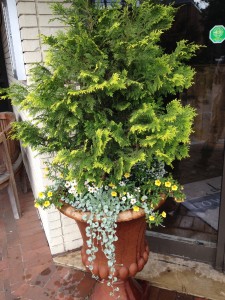 Many of you have pots that have shrubs in them that live year round, and just need some color added each season. In this example, the Chamaecyparis adds yellow foliage and is complimented through the summer with yellow million bells, white narrow leaf zinnias, silver dichondra and some euphorbia. The million bells and zinnias will be cut back when they get too leggy (There’s no need to deadhead each individual bloom on these.) and it will be watered daily, since the Chamaecyparis has been in this planter for a few years and it’s roots are filling the planter quite extensively.
Many of you have pots that have shrubs in them that live year round, and just need some color added each season. In this example, the Chamaecyparis adds yellow foliage and is complimented through the summer with yellow million bells, white narrow leaf zinnias, silver dichondra and some euphorbia. The million bells and zinnias will be cut back when they get too leggy (There’s no need to deadhead each individual bloom on these.) and it will be watered daily, since the Chamaecyparis has been in this planter for a few years and it’s roots are filling the planter quite extensively.
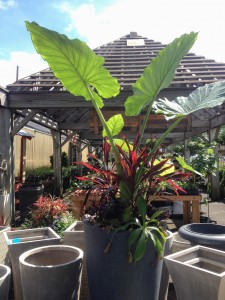 The final planting uses a dramatic, and very large Alocasia – this speaks for itself, though it has supporting players as well, including dracaena, epescia, nepenthes, and alternanthera. It’s quite a combo.
The final planting uses a dramatic, and very large Alocasia – this speaks for itself, though it has supporting players as well, including dracaena, epescia, nepenthes, and alternanthera. It’s quite a combo.
I hope this and the previous posts will give you the confidence to try new plants and combinations, to be braver about cutting plants back (Yes, they do need it every now and then!) and the understanding that these types of intensive plantings need regular water whether you’re home or not to keep them looking their best.

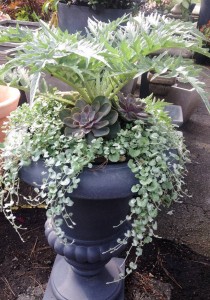

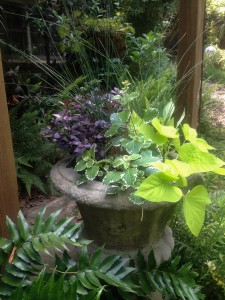
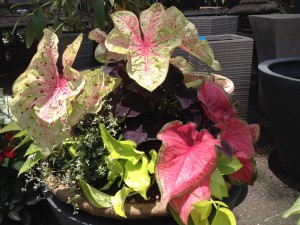
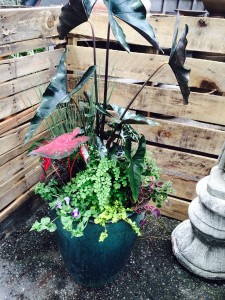 Sometimes it’s fun to try a plant that’s more unusual as the centerpiece of a design. In this glazed pot the dark leaf of the Alocasia is a beautiful contrast to the coleus, grasslike juncus, maidenhair fern, trailing torenia, and creeping jenny.
Sometimes it’s fun to try a plant that’s more unusual as the centerpiece of a design. In this glazed pot the dark leaf of the Alocasia is a beautiful contrast to the coleus, grasslike juncus, maidenhair fern, trailing torenia, and creeping jenny.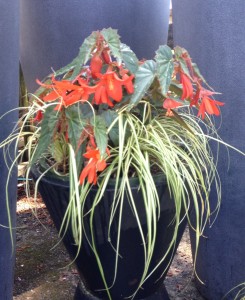 Finally, here’s a simple planting for shade using a begonia and the contrasting leaf and brightness of carex ‘Evergold’, which will spill over the edge of the container. Simple, yet effective. The begonia will continue to bloom with a couple of cutbacks if it gets “leggy.”
Finally, here’s a simple planting for shade using a begonia and the contrasting leaf and brightness of carex ‘Evergold’, which will spill over the edge of the container. Simple, yet effective. The begonia will continue to bloom with a couple of cutbacks if it gets “leggy.”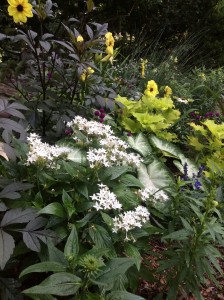
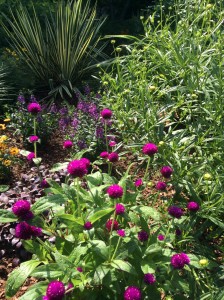
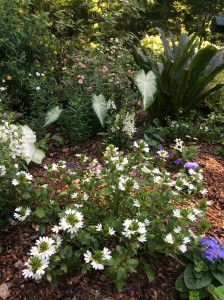
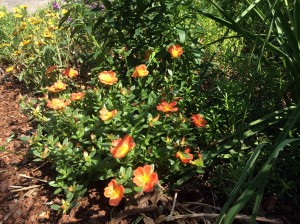
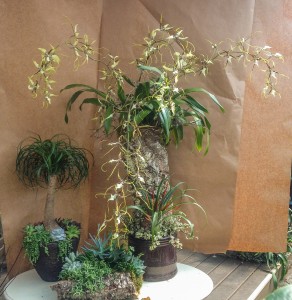 Jamie put together this stunning display the other day at the front of the shop, using a beautiful mix of containers and plants. The picture doesn’t do her designs justice,,,a pony tail palm underplanted with succulents; another succulent planting in cork bark; and a gorgeous arrangement of a standing cork bark planter with brassidium, or spider, orchids.
Jamie put together this stunning display the other day at the front of the shop, using a beautiful mix of containers and plants. The picture doesn’t do her designs justice,,,a pony tail palm underplanted with succulents; another succulent planting in cork bark; and a gorgeous arrangement of a standing cork bark planter with brassidium, or spider, orchids.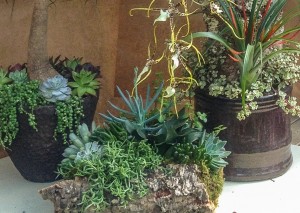
 This closeup picture of the succulent plantings shows both the diversity of this group of plants and why we enjoy working with them so much. In addition to the drought tolerant ponytail palm, there are echeverias, string of pearls, string of bananas, crassulas, and variegated trailing jade plant, all right at home in her design.
This closeup picture of the succulent plantings shows both the diversity of this group of plants and why we enjoy working with them so much. In addition to the drought tolerant ponytail palm, there are echeverias, string of pearls, string of bananas, crassulas, and variegated trailing jade plant, all right at home in her design.
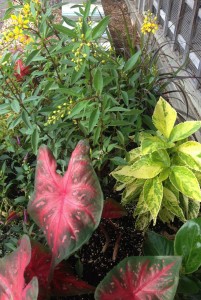 While all caladiums appreciate heat and shade, there are some that can also handle sun, including ‘Red Flash’, the one shown here. These deep red leaves will mingle with the other foliage and flowers, including a copper plant, Acalypha ‘Tahitian Gold’. It was chosen for its yellow foliage to echo the yellow blooms of the thryallis. The acalypha and a red fountain grass will grow up tall, providing a nice backdrop to this composition.
While all caladiums appreciate heat and shade, there are some that can also handle sun, including ‘Red Flash’, the one shown here. These deep red leaves will mingle with the other foliage and flowers, including a copper plant, Acalypha ‘Tahitian Gold’. It was chosen for its yellow foliage to echo the yellow blooms of the thryallis. The acalypha and a red fountain grass will grow up tall, providing a nice backdrop to this composition. Since it is a restaurant, after all, and ornamental peppers were plentiful in the nursery, those were placed next, just in front of red Dragonwing begonias. Eventually the peppers might be enveloped by the other plants, but until then they’ll contribute their small white flowers and ornamental purple peppers to the mix,
Since it is a restaurant, after all, and ornamental peppers were plentiful in the nursery, those were placed next, just in front of red Dragonwing begonias. Eventually the peppers might be enveloped by the other plants, but until then they’ll contribute their small white flowers and ornamental purple peppers to the mix,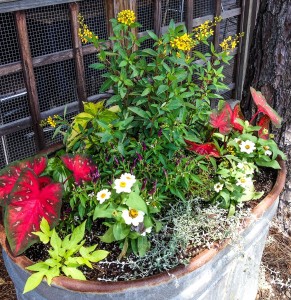 Last, a silver trailing plant. Usually I use silver dichondra for this color because it holds up extremely well in our heat and humidity where so many other silver plants fail. This year, though, I’ve decided to try a new plant…a selection of one that I haven’t had good luck with, but this is supposed to be an improved variety, so we’ll see. It’s a licorice vine, Helichrysum ‘Silver Star’. We’ll keep an eye on this one and hope for the best. It scored high marks in the University of Georgia Athens trial gardens, so I have high hopes!
Last, a silver trailing plant. Usually I use silver dichondra for this color because it holds up extremely well in our heat and humidity where so many other silver plants fail. This year, though, I’ve decided to try a new plant…a selection of one that I haven’t had good luck with, but this is supposed to be an improved variety, so we’ll see. It’s a licorice vine, Helichrysum ‘Silver Star’. We’ll keep an eye on this one and hope for the best. It scored high marks in the University of Georgia Athens trial gardens, so I have high hopes!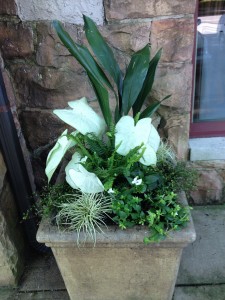 A testament to its common name of cast iron plant, the aspidistra looked amazingly good considering the bone-chilling temperatures Birmingham dipped to in January. It only needed a few leaves cut out, and no thinning was required this season…probably due to the cold. A heuchera, that had been added in the
A testament to its common name of cast iron plant, the aspidistra looked amazingly good considering the bone-chilling temperatures Birmingham dipped to in January. It only needed a few leaves cut out, and no thinning was required this season…probably due to the cold. A heuchera, that had been added in the  Torenia is an interesting plant, useful in
Torenia is an interesting plant, useful in 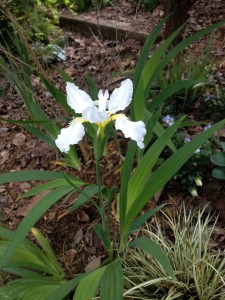
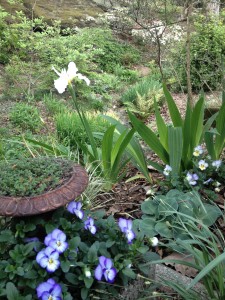
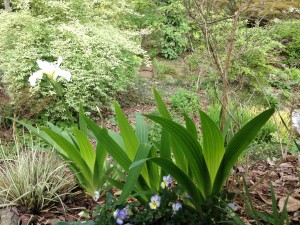
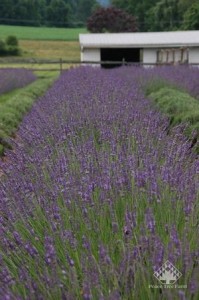
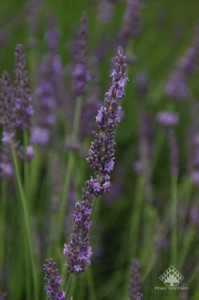
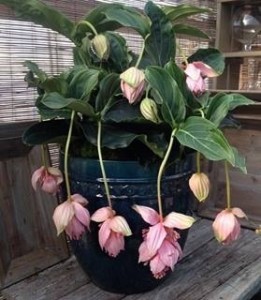 A stop you in your tracks plant, this one is very new to everyone, including us. Medilla magnifica’s origin is in the mountains of the Phillipines…and this is just one of 400 species! It’s an epiphyte in its native land, growing high in trees. What a sight that must be! Evidently the late king Boudewijn of Belgium was enamored of them, as well, growing them in his royal conservatories and using them on Belgian currency.
A stop you in your tracks plant, this one is very new to everyone, including us. Medilla magnifica’s origin is in the mountains of the Phillipines…and this is just one of 400 species! It’s an epiphyte in its native land, growing high in trees. What a sight that must be! Evidently the late king Boudewijn of Belgium was enamored of them, as well, growing them in his royal conservatories and using them on Belgian currency.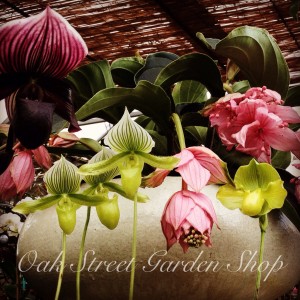
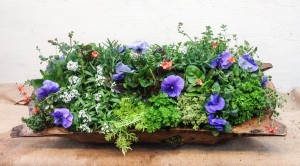
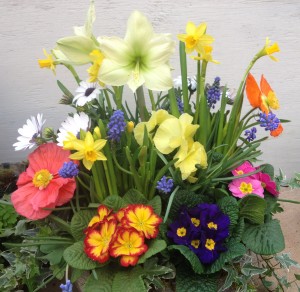
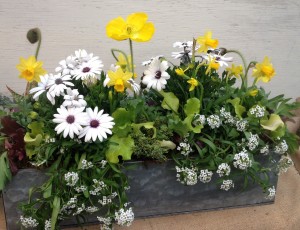

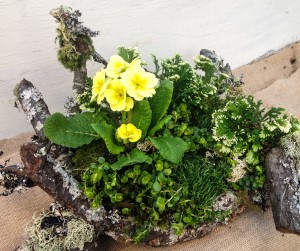
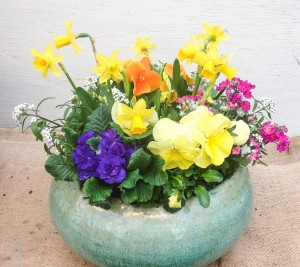
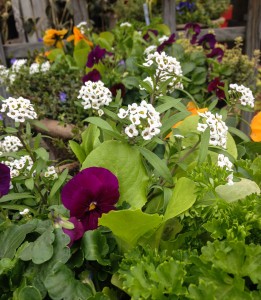
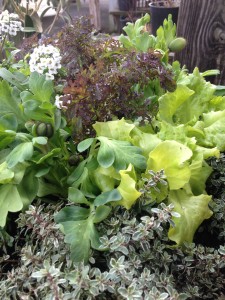
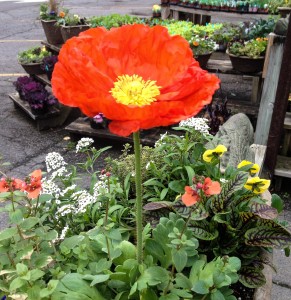
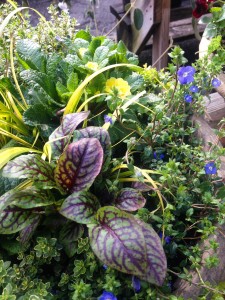
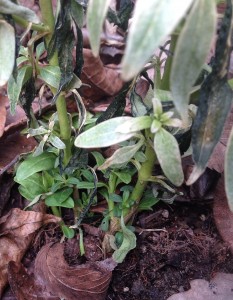
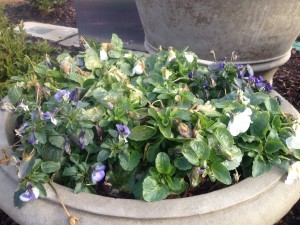
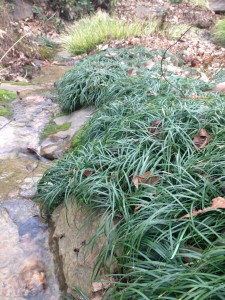
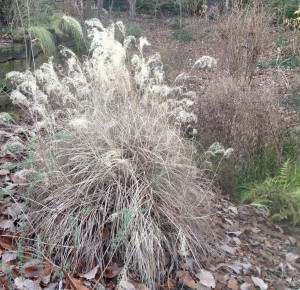
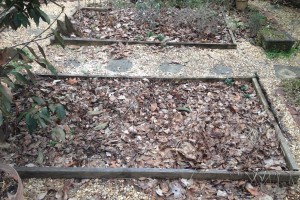
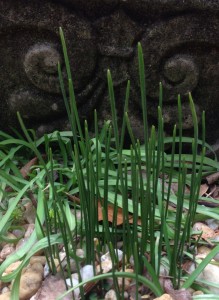
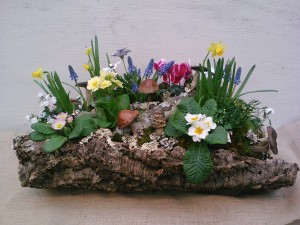
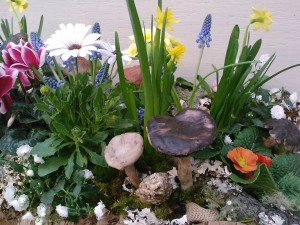 Now that January is behind us, we can look forward to spring, knowing it is right around the corner. Until then, we’ve been satisfying our planting urges using late winter offerings from growers. We are determined to come up with something interesting on long winter days in the greenhouse!
Now that January is behind us, we can look forward to spring, knowing it is right around the corner. Until then, we’ve been satisfying our planting urges using late winter offerings from growers. We are determined to come up with something interesting on long winter days in the greenhouse!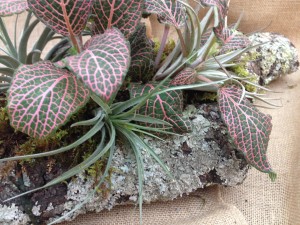
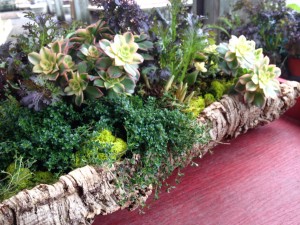
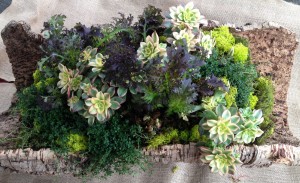 Many of the succulent aeoniums fare better here during the winter months. They seem to dislike our excessive summer humidity (Don’t we all?), and the Aeonium ‘Kiwi’ seemed just right to work into some sort of arrangement. I loved how they looked paired with this frilly dark purple leaf ornamental mustard. If I could just work it into a container that could be moved in and out easily if temperatures dropped below freezing…
Many of the succulent aeoniums fare better here during the winter months. They seem to dislike our excessive summer humidity (Don’t we all?), and the Aeonium ‘Kiwi’ seemed just right to work into some sort of arrangement. I loved how they looked paired with this frilly dark purple leaf ornamental mustard. If I could just work it into a container that could be moved in and out easily if temperatures dropped below freezing…

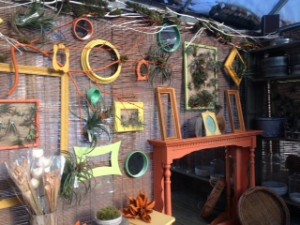

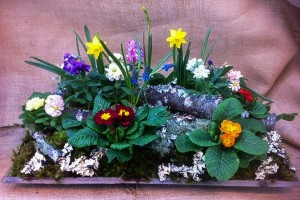
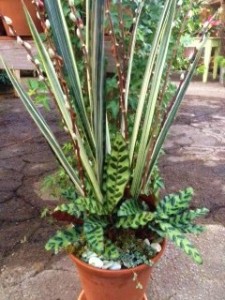
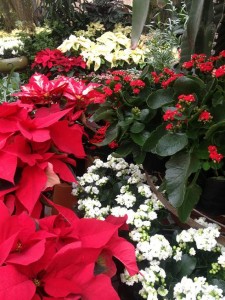 The greenhouse is so beautiful all year round, but it’s especially so in the height of the holiday season. In fact, sometimes there are so many flowers and new plants coming in almost daily that they are literally everywhere – on tables, on the floor around tables, and anywhere we can find a spare space. Never let it be said we don’t have a little something for everyone!
The greenhouse is so beautiful all year round, but it’s especially so in the height of the holiday season. In fact, sometimes there are so many flowers and new plants coming in almost daily that they are literally everywhere – on tables, on the floor around tables, and anywhere we can find a spare space. Never let it be said we don’t have a little something for everyone!
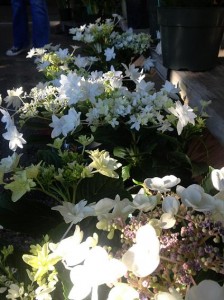
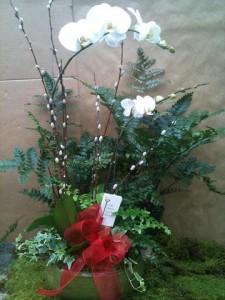
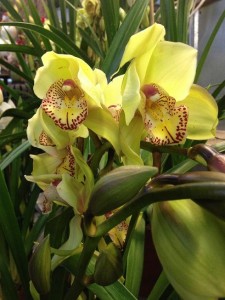

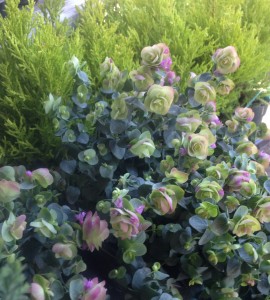
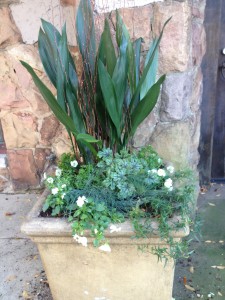
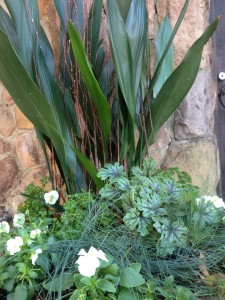 The emphasis is on foliage, though, and I’ve included curly parsley for it’s fresh green color, a small blue fescue grass, and a shade loving heuchera for this planting. Holdovers from the summer are aspidistra, which I thin out each season, and a tiny leaf green ivy. After planting, I added birch branches to add more height and winter interest. (Branches are an easy way to get color in planters during the holiday – red twig dogwood branches would also be pretty.) While it looks a bit top heavy with the tall aspidistra at first, the parsley and heuchera will add fullness to the composition as it grows in. I’m also trying the Cool Wave white trailing pansies here this year, hoping they get enough sun to bloom well.
The emphasis is on foliage, though, and I’ve included curly parsley for it’s fresh green color, a small blue fescue grass, and a shade loving heuchera for this planting. Holdovers from the summer are aspidistra, which I thin out each season, and a tiny leaf green ivy. After planting, I added birch branches to add more height and winter interest. (Branches are an easy way to get color in planters during the holiday – red twig dogwood branches would also be pretty.) While it looks a bit top heavy with the tall aspidistra at first, the parsley and heuchera will add fullness to the composition as it grows in. I’m also trying the Cool Wave white trailing pansies here this year, hoping they get enough sun to bloom well.
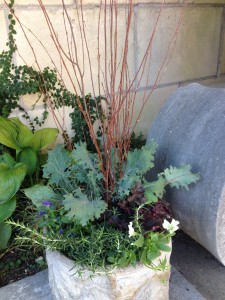 This fall Pardis asked if I would also take a look at the planters at Bottega, their other wonderful restaurant.
This fall Pardis asked if I would also take a look at the planters at Bottega, their other wonderful restaurant. Autumn inspires us! The past month we’ve been designing with thoughts of fall…a copper container, a beautiful basket, a heavy stone trough, and even something as simple as a wooden box made wonderful starting pieces for a few of them.
Autumn inspires us! The past month we’ve been designing with thoughts of fall…a copper container, a beautiful basket, a heavy stone trough, and even something as simple as a wooden box made wonderful starting pieces for a few of them.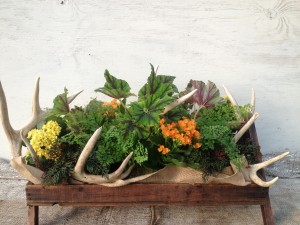 This wooden box arrangement was done for a garden club – the customer brought in the antlers! This one was a fun change of pace. Those antlers didn’t want to stay put, and the box was a tad rickety…it reminds us that each day may bring different and interesting challenges!
This wooden box arrangement was done for a garden club – the customer brought in the antlers! This one was a fun change of pace. Those antlers didn’t want to stay put, and the box was a tad rickety…it reminds us that each day may bring different and interesting challenges!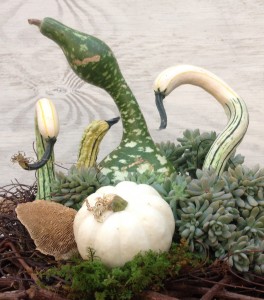


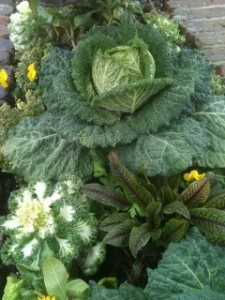
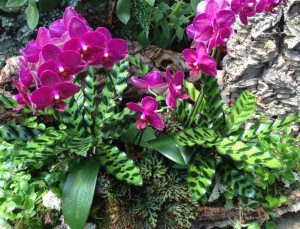 This summer’s wet, cool weather might have kept many of you out of your gardens, but we’ve managed to stay busy in the greenhouse putting together arrangements filled with orchids, succulents, houseplants, and so much more…here’s a peek at some of them. We regularly have folks who stop in just to see what we’ve been working on! All of these arrangements are composed of live plants, no cut flowers here.
This summer’s wet, cool weather might have kept many of you out of your gardens, but we’ve managed to stay busy in the greenhouse putting together arrangements filled with orchids, succulents, houseplants, and so much more…here’s a peek at some of them. We regularly have folks who stop in just to see what we’ve been working on! All of these arrangements are composed of live plants, no cut flowers here.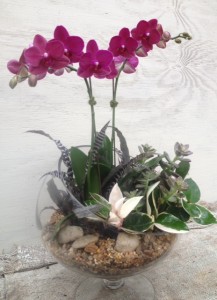
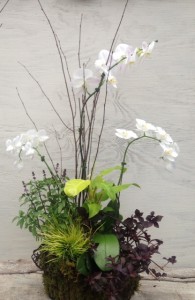
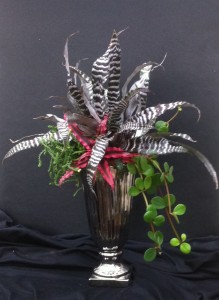 Finally, the silver container was given in memory of someone…the longlasting and low maintenance houseplants of trailiing pepperomia and cryptanthus make excellent companions. It’s gratifying, also, to know that whoever is on the receiving end will be able to enjoy this longer than a fresh flower arrangement could ever hope to last.
Finally, the silver container was given in memory of someone…the longlasting and low maintenance houseplants of trailiing pepperomia and cryptanthus make excellent companions. It’s gratifying, also, to know that whoever is on the receiving end will be able to enjoy this longer than a fresh flower arrangement could ever hope to last.